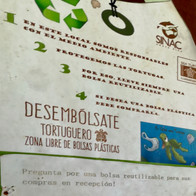🇬🇧 Results of a sustainable tourism exploration in Costa Rica ✈️🌿
- Melissa Laroche
- 4 janv. 2019
- 8 min de lecture
🇫🇷 Cet article est également en VF, ici.
What about Sustainable Tourism in Costa Rica ?
« You’ll see, Costa Rica is the perfect place for ecotourism! »
Costa Rica, a « green paradise », champion in sustainable practices.
That’s at least how the country is seen from abroad and what Costa Rica communicates on their touristic promotion website.
Anytime I mentioned my trip there to explore sustainable tourism initiatives, the most spontaneous reaction was « You’ll see, Costa Rica is the perfect place for ecotourism! ». So, there was I going, to the land of sustainable tourism and sustainability, right ? As I said before, Costa Rica has 26% of their land devoted to natural and protected reserves in which you can find 4% of the world’s biodiversity¹; most of the energy they produce is green (around 98% today) and Costa Rica is a peaceful country with no armed forces and a positive country-wide saying « Pura Vida ».
Due to these information, found along with the paradisiac pictures of their beaches, volcanoes, extreme and adrenaline adventures possibilities, wildlife and so on, Costa Rica seems to attract very different « categories » of tourists. All of this is true : The country really has a lot of protected areas, greener than you can imagine and with an incredible quantity and diversity of wild-life to observe. There is also a lot of eco-lodges and most of the hostels recycle and promote recycling, water saving and other sustainable practices like avoiding plastic, using a local currency or supporting animals conservancy (see pictures below).
Nevertheless, one thing I would like to make clear :
It is not because you are travelling to Costa Rica that you are a sustainable tourist.
But it neither is if you are travelling to Costa Rica with an electrical rental car and going to completely sustainable eco-lodges. Let’s understand why :
Sustainable tourism is based on 3 principles : (summing it up in really short)
Sustainable tourism doesn't harm the environment (and maybe even conserve it)
Sustainable tourism empowers local communities
Sustainable tourism contributes to the local economy and doesn’t create economic inequalities
Now let’s see what is happening in Costa Rica.
🚍 Transportation systems : the difficulty of planning ahead and a car birth rate higher than babies
One of the first things I realized about traveling in Costa Rica was the difficulty to try to organize anything at home. I’m not talking about making any reservation, but even defining a route was hard enough to make me quit. The transportation system isn’t bad , the only problem is that the information and timetables related to it change a lot and aren’t available anywhere apart in local shops or bus stations (even Rome2Rio wouldn’t find it sometimes).
Also, some destinations are hard to connect between each other which forces you to go back to the capital each time. There is no train lines neither (that will take you any further than the San José suburbs).
I can imagine that theses reasons highly contribute for the amount of rental cars and specially SUVs in Costa Rica (and maybe also a bit of the American influence goes into that?). In a country that produces so much clean energy, I find it a bit sad that there is so many cars and pollution because of it. In 2017, Costa Rica had the 2nd biggest quantity of cars of Central America. There is twice as much new cars than newborns every year in CR.
Do I need to explain why renting your own gigantic car for sometimes 1 to 2 people is not so sustainable ?
🏠 Ecolodges : How paying 600$ dollars a night might help (or not) the local environment and communities
Costa Rica houses stunning and sustainably remarkable eco-lodges that ticks all the boxes of sustainability practices. Lapa Rios is one of them, with all the national certifications on sustainable tourism and it even was featured in the National Geographic.
I’ve seen many ecolodges like this one in Costa Rica and everything is thought trough (water, waste, energy, building materials, food, workforce, projects built for the local communities etc).
This project, definitely have the power to contribute positively to their surroundings environments and communities but :
This kind of place is usually expensive (Lapa Rio has a minimum of 600$/ a night). This only makes it accessible to the 1% that goes to Costa Rica and is rich enough to afford a stay like this.
Will it transforme tourism and make it more sustainable by changing the mind of the 1% ? Speaking about changing mindsets… Is it going to happen in a place as comfortable (probably much more comfortable actually) than your place ? Where the only locals working there, are working to serve their client ? In these kind of situations, there will never be a balanced exchange between the local and the tourist.
They are often really remote, which makes it once again only accessible if you reach it by car. It makes it really hard to pop by and see their projects (which is one of the reasons why I couldn’t pay a visit to any of these luxury yet sustainable resorts).
I don’t want to say these ecolodges are bad, they surely bring a lot of employment opportunities and sustain a lot of projects of the local communities around. Although, I question their contribution to a sustainable development of their surroundings.
To me, there is also a distinction to be made between truly sustainable places, and some that are less sustainable but with a lot of marketing and actions to « repair » their bad actions.
💡Tourism, often appears as a perfect gateway for locals who slowly quit their agro-pastoral and fishing activities. This might disturb the social and economical balance of some communities when most of them go work for a hotel nearby thinking of the sexy image it has, less drudgery and more revenue. The consequences might have an impact on local development : job insecurity, lack of employment contracts, lower wages than foreign employees, and a state of servitude towards the tourists or the company itself. Also, introduction of these jobs might create economical disparities inside these same communities where some people are still working the traditional jobs.
Therefore, these initiatives should anticipate these drifts to solve them before they happen.
👉 It is therefore maybe a good idea to ask some questions before booking a hotel or let labels and certifications speak ;-)
📖🗺️ Travel routes and travel guides : How not to follow the guide and the « 10 highlights of ... »
Are you familiar with the 20 first pages of the book, that use beautiful and glossy images to promote the destination with all the highlights of the country, making you desperate to visit every single piece of it and then offering a tour that concentrates the most of these activities in 10 or 15 days ?
In Costa Rica, some guides will tell you to take 7 destinations in 10 days which will satisfy your needs for wildlife watching, relaxation, surfing and beaching, adrenaline activities and hiking through the jungle. Doesn’t it sound perfect ?
This is one of the major reasons why 5 of these 7 destinations have big environmental warnings nationally. They are exceeding their capacity of charge, growing out of control or damaging local communities or wildlife. And frankly, with most of Costa Rica’s tourists in theses places, it doesn’t resemble Costa Rica at all.
CANAECO (National Chamber of Ecotourism) and ICT (Costa Rica's Tourism Institute) both affirm that these places grew out of control because they sometimes didn't have a development plan that was set up right at the beginning.
The most blatant examples are Jacó or Manuel Antonio. First one has seen many casinos, all-inclusive resorts and huge residencies popping in the landscape really quickly. They usually don't fit at all with the landscape and with the lifestyle of the inhabitants because of the lack of this development plan we were speaking of. In the case of Manuel Antonio, 2nd most visited park of the country, it's the attractiveness of the park that led to a burst of infrastructures all around. These started blocking the park and its biological corridor that allowed the animals in the park to communicate with other regions and national parks (which created a consanguinity problem for monkeys and therefore altered their behavior). Even if forbidden, Manuel Antonio has a lot of tourists feeding the animals which also made them much more aggressive towards men, associating them with food.
(on the left, Manuel Antonio town situated next to the town, and on the right, Jacó beach)
What to do then ? 🤷♂️
It is important to try and go further these pages and really document ourselves on the country we are visiting if we want to have a positive impact. For me, my two highlights of the trip were Osa peninsula and Reserva Biologica Dúrika but I will make another article about my itinerary and about how to build your own.
You might be wondering « What makes a tourist, a sustainable one, then ? »
I guessed that if you are still reading, you might be.
Well, in Costa Rica, even if travelling sustainably is not obvious, it is still easier than in other places. As I said at the beginning of the article, there is a lot of places that are already adopting waster and water sustainable practices.
✨🌍Here are some tools and ideas to be more sustainable while travelling 🌍 ✨
In general, try travel less often, for a longer period of time, and if you can, low-season.
If you’re flying, you can compensate your carbon emissions by supporting sustainable projects or planting trees. GoodPlanet Foundation, ClimateCare.org and Reforest’Action are the ones I know. (Prices differentiate from one site to another, it is more expensive to plant a tree than offsetting your carbon conceptions through a donation)
Organize some aspects of your trip or itinerary (before or while in the country) in order to understand the country’s political, social and economical context, identify local initiatives and areas that are away from these first itineraries you find in your travel guide. If you can’t organize it yourself, then some sustainable agencies might help you out (make sure to look for them before booking with another travel agency. Disclaimer : I’m not saying you should prepare everything before your trip, you can still be open to discover new or unplanned things on the way, but it’s good to set up objectives at the beginning of the trip.
In Costa Rica, some local agencies organize regional trips or in the whole country : 👉ATEC 👉Fundacion Durika 👉Turismo Autentico
Use some tools that will help you plan along the way : 📱FairTrip that is a search engine for authentic experiences and restaurants out of the beaten path. It will guarantee that you are supporting local economy. App is downloadable here for apple and android. 📚Sustainable guides that will guide you through local and environmentally sustainable initiatives. In French, Via Tao is really good. Usually these kinds of guides won’t give an exhaustive list of places to go and visit. They will give a sense of where to go and how to chose your destinations depending on what you like but always with a matter of being sustainable (socially and environmentally). 💻Websites like EchoWay or blogs of sustainable travelers like GreenPick
Have in mind to always support the local economies and apply it to your search of accommodation, restaurants or activities. This also applies to souvenirs. Most of the souvenir shops, no matter how authentic they look, get a lot of supplies from China. Try to orient yourself towards cooperatives, local artisans, etc.
I will definitely make an article about my trip in Costa Rica, the places I’ve been, how I found them etc. Meanwhile, if you are travelling there soon, you can visit my instagram where I highlighted the areas I loved and why.
SOURCES
¹ Costa Rica’s biodiversity data : Biodiversity finance data : https://www.biodiversityfinance.net/costa-rica Research paper on Biodiversity and conservation in Costa Rica (page 2) : https://www.researchgate.net/publication/236592513_Biodiversity_conservation_and_hotspot_atlas_of_Costa_Rica
📚Books that I read and helped me prepare my trip
Jean-Pierre Lamic - Tourisme Durable : Utopie ou Réalité ? Comment identifier les voyageurs et voyagistes éco-responsables ?
Sylvain Lefebvre et Sylvain Mahuzier - Les clés pour bien voyager "Costa Rica"
Costa Rica, le plaisir de mieux voyager - Éditions Guides Ulysse
🙏Special thanks to you
👉To Rachel & Alonso who shared their love and hospitality with me while in San José
👉To Svenja & Marco, loyal companions of this trip and life-savers
👉To Olga & Marianne from the Costa Rican French Embassy that provided me with precious tips and information.
👉To ICT, CANAECO, ATEC, AdiCorcovado, La Tarde, Durika for enlightening me and giving me a lot of information so i could understand better tourism in Costa Rica.
There will be more articles about :
The sustainable tourism paradox
How to be a sustainable tourist 101
My sustainable travel guide to Costa Rica and how to build your own

























Commentaires